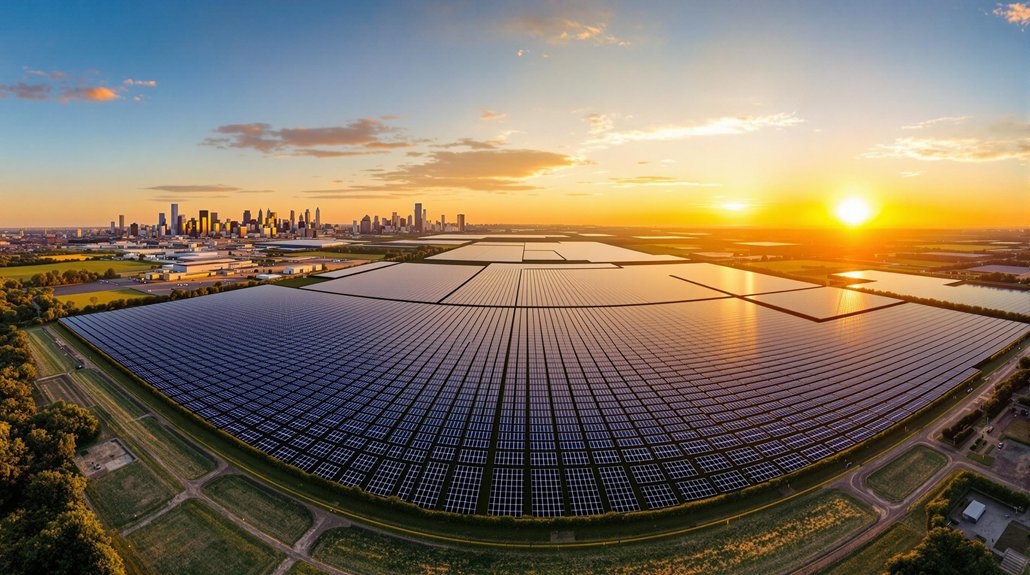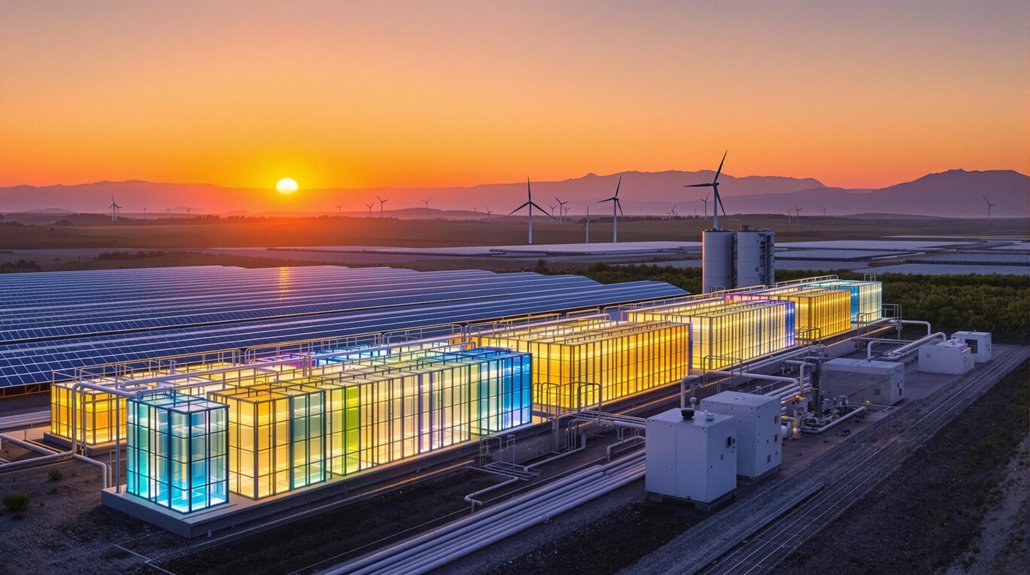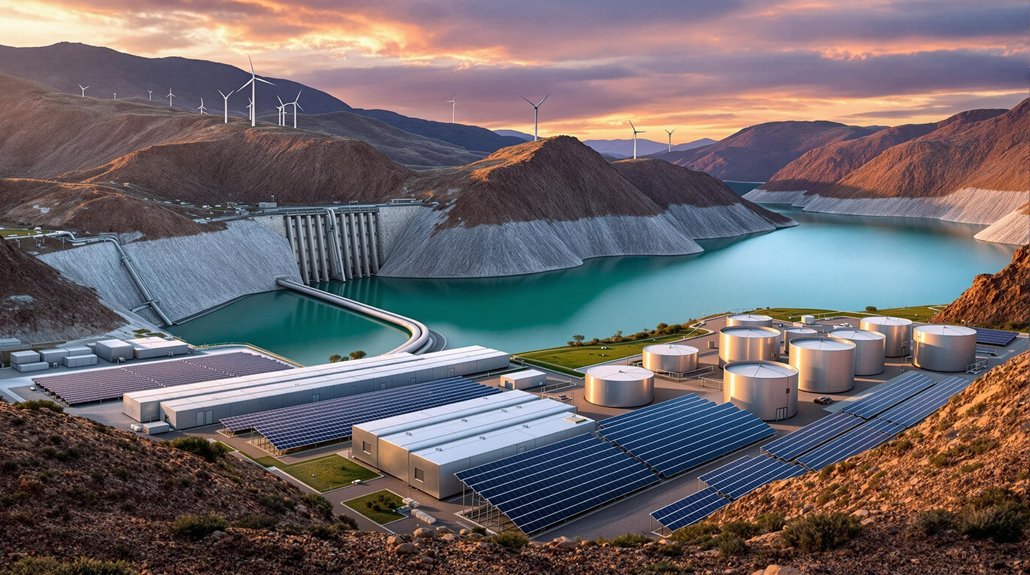Solar energy delivers substantial economic benefits across the U.S. The industry created over 263,000 jobs in 2022, growing 5.4% from the previous year. Homeowners save 20-30% on electricity costs, while property values increase by about 4.1%. Businesses reduce operational expenses markedly. With solar accounting for half of new electricity generation capacity and attracting $30 billion in investments, the economic sunshine extends beyond individual savings to community-wide prosperity.

A powerhouse of economic opportunity, the solar industry continues to transform America’s energy landscape while delivering considerable financial benefits. In 2022, the solar sector employed 263,883 workers across all 50 states, with job growth of 5.4% from the previous year. Importantly, 57% of these new positions didn’t require a bachelor’s degree, making solar careers accessible to a wide range of workers. Experts predict solar manufacturing jobs will triple by 2033, creating even more opportunities.
Homeowners and businesses are seeing direct financial benefits from solar installations. Residential systems typically reduce electricity costs by 20-30%, while businesses can greatly lower their operational expenses. The federal tax credit of 30%, available until 2032, makes solar more affordable. Many states offer additional incentives, and net metering programs allow users to sell excess energy back to the grid.
Solar installations deliver measurable savings while tax credits and incentives make the switch increasingly affordable for everyone.
The industry’s growth is impressive, with solar accounting for half of all new electricity-generating capacity added in 2022. U.S. solar companies invested over $30 billion that year, and utility-scale installations grew 114% in 2023. This expansion stimulates local economies and attracts new businesses to communities embracing solar energy. The impressive 219 gigawatts capacity nationwide now powers more than 37 million American homes, demonstrating solar’s substantial contribution to the national energy mix.
Property owners also see increased value from solar installations. Homes with solar panels sell for 4.1% more on average, approximately $15,000 higher than comparable homes without comparable homes without solar. These properties also tend to sell faster, and the increased values contribute to the local tax base.
Solar energy enhances America’s energy independence by reducing reliance on imported fossil fuels. This decentralized approach to energy production increases grid resilience and stabilizes energy costs for consumers and businesses. Investments in solar power provide predictable energy costs that shield users from the volatility typically associated with traditional energy sources.
The industry drives innovation in energy storage and smart grid technologies, attracting venture capital and spurring research across related fields. Additionally, solar energy delivers environmental economic benefits by reducing healthcare costs related to air pollution, lowering water usage compared to traditional power generation, and creating opportunities in carbon credit markets. Solar installations also contribute to long-term energy savings that help owners recover their initial investment while promoting sustainable local energy production.
These combined factors make solar a growing economic force in America’s future.
Frequently Asked Questions
How Long Does It Take to Recoup Initial Solar Installation Costs?
Solar installation costs are typically recovered within 6-10 years in the U.S., with the national average being about 8.3 years.
The payback period varies based on several factors: installation costs, available incentives, local electricity rates, sunlight availability, and household energy use.
In areas with high electricity costs, payback can be as quick as 5 years.
Solar panels generally last 25-30 years, providing many years of savings afterward.
Can Solar Panels Work Effectively in Cloudy or Cold Climates?
Solar panels do work in cloudy and cold weather, though with reduced output.
On cloudy days, panels still generate 10-25% of their normal power. Cold temperatures actually improve panel efficiency.
Countries like Germany, with frequent cloud cover, have thriving solar industries. Modern technology helps maximize performance in these conditions.
Panels can use diffuse light and even benefit from snow reflection in winter months.
What Happens to Solar Panels at the End of Their Lifecycle?
Solar panels typically last 25-30 years before needing replacement.
At their lifecycle’s end, they’re disconnected from the electrical grid and removed from their installation site.
While recycling options exist—with 95% of glass and 100% of metal parts being reusable—the process faces challenges.
Specialized facilities can separate components through thermal or chemical processes.
The industry’s working on better recycling methods as millions of tons of panel waste are expected by 2030.
How Much Maintenance Do Residential Solar Systems Require?
Residential solar systems need minimal maintenance.
They typically require annual professional inspections costing $150-$300. Panels need cleaning 1-2 times per year, with more frequent cleaning in dusty areas. Rainfall often cleans panels naturally.
Homeowners should monitor system performance monthly and check for debris or damage.
Additional tasks include trimming nearby trees to prevent shading and clearing heavy snow accumulation in winter.
Are There Tax Incentives Available for Commercial Solar Installations?
Commercial solar installations qualify for several tax incentives.
Businesses can claim the 30% Federal Investment Tax Credit on total system costs through 2032. Alternatively, they might choose the Production Tax Credit of 2.75 cents per kWh for 10 years.
The MACRS program allows businesses to depreciate solar assets over just 5 years, reducing taxable income.
State and local governments often provide additional incentives like property tax exemptions.









